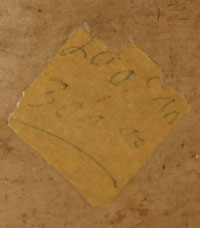Very Large Historic Cochiti Pueblo Polychrome Pottery Storage Jar
+ Add to my watchlist Forward to Friend
Forward to Friend
- Category: Historic
- Origin: Cochiti Pueblo, KO-TYIT
- Medium: Native Clay
- Size: 19-1/2 inches x 19-1/2 inches
- Item # 22257
- Price Available On Request
The Artistry and Utility of the Cochiti Pueblo Polychrome Pottery Storage Jar
This grand Cochiti Pueblo Polychrome Pottery Storage Jar, a testament to the exquisite craftsmanship of the era, boasts a relaxed decorative style typically associated with vessels predating the 1900s. It stands as a stellar representation of a traditional Cochiti Pueblo storage jar.
Constructed with the primary purpose of in-house storage for grain, corn, or other dry goods, this jar likely hails from around 1880 and remains in remarkable condition. As a utilitarian vessel intended for domestic use, it wasn't deemed necessary for the potter to invest time in crafting black paint from the leaves of the Rocky Mountain Bee plant for the jar's decoration. However, potters hold the belief that a pottery vessel's creation isn't complete without decoration. The essence of making a vessel lies not in the design placed on it, but in the act of painting a design on the piece. Once adorned, the vessel is deemed complete and ready for use.
In a display of practicality, a potter would often craft a pottery bowl to serve dual purposes - as a bowl when required, and as a lid for a storage jar. This approach was far more practical than creating a traditional lid with no other function. It was also customary to cover the jar's opening with a towel or other fabric. If this storage jar had been routinely covered with an upturned bowl, there would be signs of abrasion around the trim and on the shoulder, which this jar notably lacks.

Cochiti Pueblo residents speak the Keresan language, along with their northeast Keres neighbors, Kewa and San Felipe. The three pueblos are strongly religious in both the Roman Catholic and their own Native religion. Their association with non-native peoples is not as homogenous, however. Kewa is more conservative in protecting its beliefs and lifestyle that either Cochiti or San Felipe. Cochiti is more open about painting religious symbolism on secular pots whereas Kewa would not do so. San Felipe is located closer to Interstate 25 than Cochiti and operates a casino open to the public.
Cochiti Pueblo has been in its present location since before 1700. Its current population is around 1500. It has a long history of producing beautiful pottery for use at the pueblo and for producing large quantities of figurative pottery for sale to merchants in Santa Fe. The potters seem to be better known for the figurative pottery than for vessel-shape pottery, but the latter has always been produced for pueblo use as well as for sale.
Francis H. Harlow, in Matte-Paint Pottery of the Tewa, Keres, and Zuni Pueblos, states:
". . .[P]rior to about 1830, there is no evidence by which the wares of [Santo Domingo] and Cochiti can be distinguished. Indeed, I doubt that some of the later more formal Cochiti vessels can be separated from those of Santo Domingo. Starting about 1820, a guess that may be off either way by 20 years, the ceramics of Cochiti and Santo Domingo began to diverge significantly. The collections by Stevenson in 1880 show considerable difference between the two villages." [Harlow 1973:47]
Condition: this jar is in good condition with minimal wear from use as is expected for a jar of this age. There is an old tag attached to this jar that was left on for historical purposes. It suggests that at one time, this jar had an asking price of only $300.
Provenance: this Very Large Historic Cochiti Pueblo Polychrome Pottery Storage Jar is from a private California collection.
Recommended Reading: Matte-Paint Pottery of the Tewa, Keres, and Zuni Pueblos by Francis H. Harlow
TAGS: Southwest Indian Pottery, Cochiti Pueblo, Historic Pottery, Kewa Pueblo, San Felipe Pueblo, painting
- Category: Historic
- Origin: Cochiti Pueblo, KO-TYIT
- Medium: Native Clay
- Size: 19-1/2 inches x 19-1/2 inches
- Item # 22257
- Price Available On Request
Adobe Gallery Recommended Items
If you are interested in this item, we would also like to recommend these other related items:



